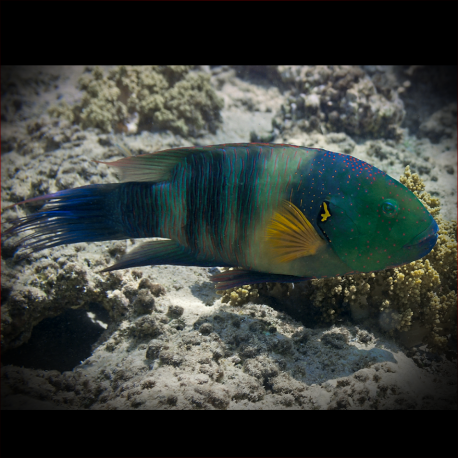More info
Datasheet
| Minimum Tank Size | 2000 litres / 528.34 US gallons |
| Maximum Size | 50.0cm / 19.69inches |
| Reef Compatible | Not reef safe |
| Temperament | Might be aggressive towards other species |
| Temperature | 22.2°C / 71.96°F - 25.6°C / 78.08°F |
| Specific Gravity | 1.020-1.025 |
| Carbonate Hardness | 8-12 |
| pH | 8.1-8.4 |
General Description
The Broomtail wrasse, scientifically known as Cheilinus lunulatus, belongs to the Labridae family and can grow up to an impressive size of 50.0cm, making them larger than most wrasse species. These fish are native to the Western Indian Ocean, specifically from the Red Sea to the Gulf of Oman. With a striking appearance and a unique temperament, they are characterized by their broom-like tail fin and herbivorous nature.
Aquarium Suitability
The Broomtail wrasse is considered suitable for aquariums with caution. They require a very large tank, at least 2000 liters when fully grown, which can be a challenge for many hobbyists. Additionally, they can be a threat to small fish and invertebrates like shrimps, crayfish, crabs, and snails, making tankmate selection crucial.
Demands, Care and Hardiness
This species has an average hardiness level and demands specific care. Broomtail wrasses prefer hiding places within live rocks and may initially hide while acclimatizing to their environment. They thrive in tanks with ample swimming space, and it is recommended to provide them with a varied diet consisting of fish, crustaceans, and other invertebrates.
Reef Suitability
The Broomtail wrasse is not reef-safe due to its predatory nature towards many invertebrates commonly found in reef environments. They may rearrange rocks and sand in the tank, highlighting the importance of secure placement of tank decorations to prevent any damage.
Aquarium Setup
When setting up an aquarium for Broomtail wrasses, it is essential to include ample hiding spots and secure rock structures. Maintaining stable water parameters with a temperature range of 22.2-25.6°C, pH level between 8.1-8.4, and a specific gravity of 1.020-1.025 is crucial for their well-being.
Behaviour
These wrasses can exhibit aggression towards other species, especially when first introduced to a new environment. They may also be sensitive to stress caused by other fish or disturbances from aquarists, underscoring the importance of proper acclimatization.
Feeding and Diet
Broomtail wrasses are initially best fed with living foods and later transitioned to large pieces of seafood every day or every other day. They require a varied diet consisting of live fish, larger crustaceans like shrimp and crabs, and other invertebrates to meet their nutritional needs.
Dimorphism and Captive Reproduction
These wrasses are hermaphroditic, with the capability to change gender from female to male as needed. Captive reproduction may be possible in controlled aquarium environments, providing insight into the fascinating reproductive biology of this species.
Habitat and Distribution
In the wild, Broomtail wrasses are commonly found in the East and West Indian Ocean, with their range extending from the Red Sea to the Gulf of Oman. They inhabit rocky reefs and coastal areas where they can forage for their preferred prey items and seek shelter among crevices and rocks.

